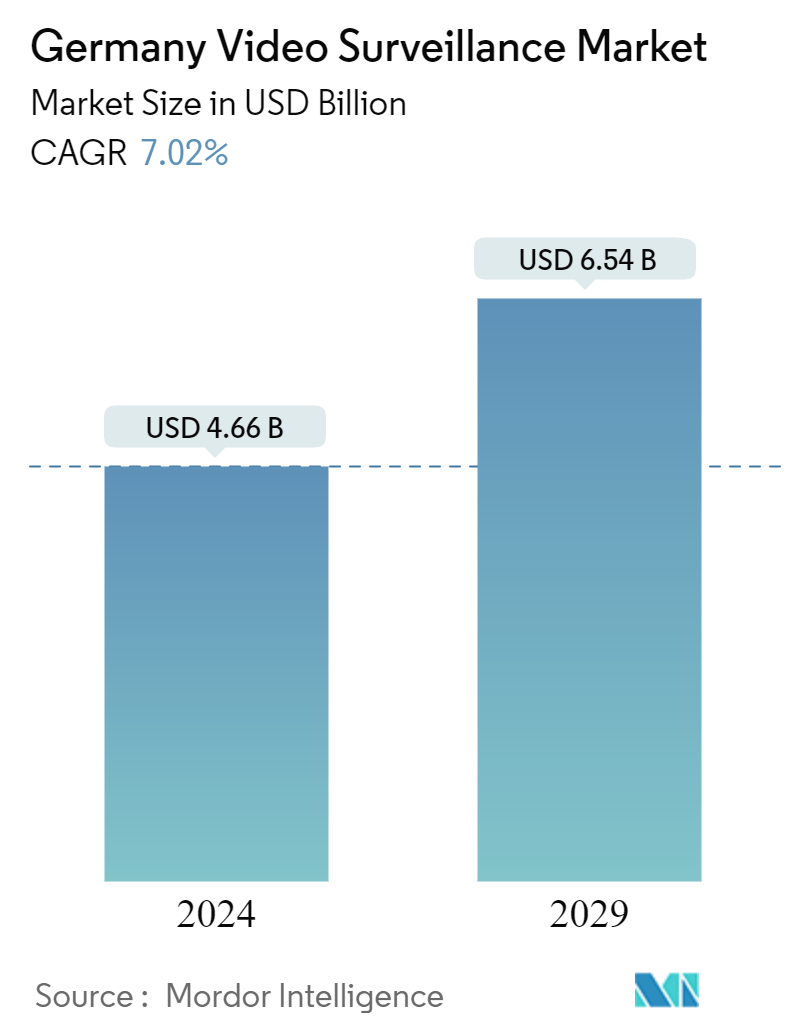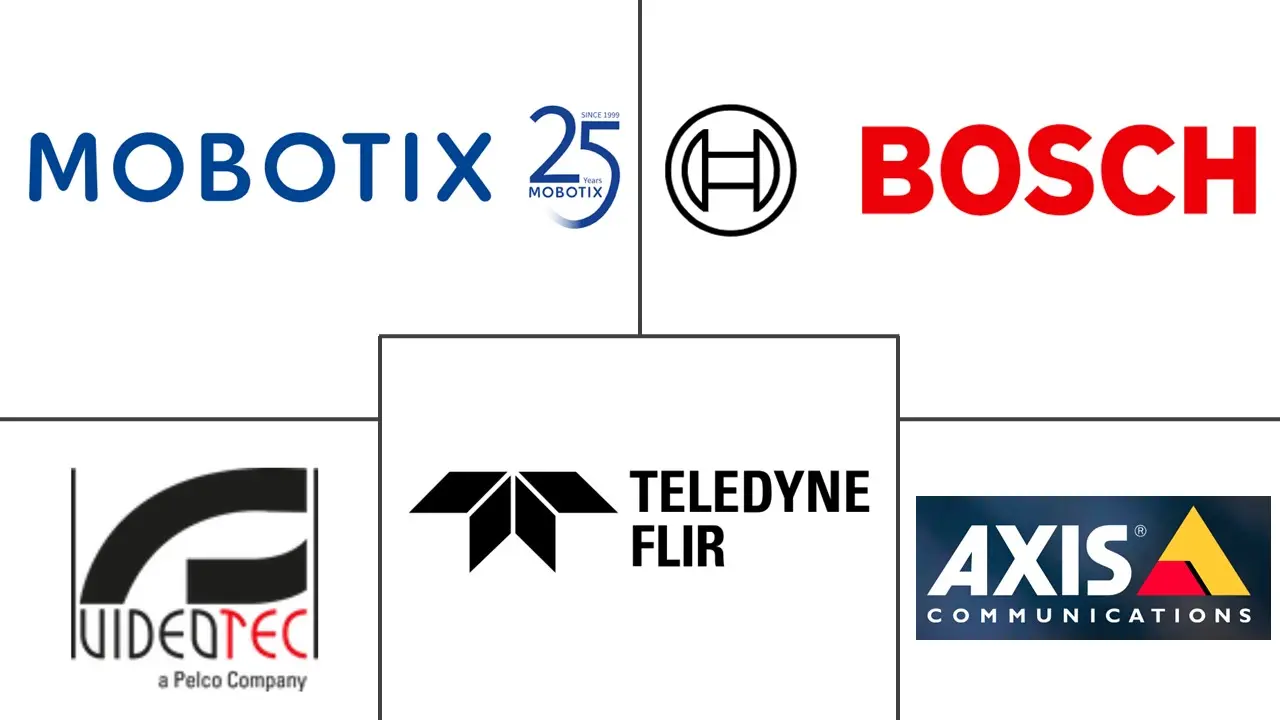
| Study Period | 2019 - 2029 |
| Base Year For Estimation | 2023 |
| Forecast Data Period | 2024 - 2029 |
| Market Size (2024) | USD 4.66 Billion |
| Market Size (2029) | USD 6.54 Billion |
| CAGR (2024 - 2029) | 7.02 % |
| Market Concentration | Medium |
Major Players
*Disclaimer: Major Players sorted in no particular order |
Germany Video Surveillance Market Analysis
The Germany Video Surveillance Market size is estimated at USD 4.66 billion in 2024, and is expected to reach USD 6.54 billion by 2029, growing at a CAGR of 7.02% during the forecast period (2024-2029).
The need for enhanced security and safety measures is a primary driver behind the adoption of video surveillance in Germany. With growing concerns about crime, terrorism, and public safety, organizations and individuals are turning to video surveillance as a proactive measure to deter potential threats, monitor activities, and provide evidence in case of incidents.
Germany has stringent data protection regulations, including the General Data Protection Regulation (GDPR). Video surveillance systems must comply with these regulations, ensuring the protection of individual privacy and the secure handling of personal data. As a result, organizations are adopting video surveillance solutions that meet legal requirements, including data encryption, access controls, and privacy-enhancing features. Hence, in most cases, before adopting a video surveillance system, the decision-makers think first and foremost of the General Data Protection Regulation (GDPR), the German Federal Data Protection Act (BDSG), or state data protection laws.
Further, video surveillance systems help gather business intelligence and improve operational effectiveness. Hence, commercial businesses in several sectors, such as retail, transport, and hospitality, can derive valuable information from advanced analytics like people counting, heat mapping, or queue management. Organizations can optimize operations, improve customer experience, and make informed decisions through video surveillance information.
Moreover, the German government and municipalities invest in developing innovative city initiatives and public infrastructure projects. For instance, in August 2023, the Federal Ministry for Digital Affairs and Transport (BMDV) announced that the German cabinet had allocated EUR 12.5 billion to rail from the Climate and Transformation Fund (KTF), prioritizing this climate-friendly mode of transport. Video surveillance plays a crucial role in these endeavors by enhancing public safety, traffic management, and urban planning. As a result, there is a growing demand for video surveillance hardware, software, and services to support these initiatives.
In addition, there is a greater awareness of the benefits and capabilities of video surveillance systems. Advancements in technology, such as high-resolution cameras, intelligent video analytics, and cloud-based solutions, have made video surveillance more effective, reliable, and accessible. This has increased the acceptance and adoption of these systems across various sectors.
However, there is a heightened sensitivity to privacy concerns in Germany, which may hurt the growth. For instance, the increasing use of facial recognition technology in video surveillance systems creates concerns such as improper data storage, misuse of data, and infringement on individual privacy, which may restrict market demand.
Germany Video Surveillance Industry Segmentation
A video surveillance system comprises cameras, monitors, display units, and recording equipment. Different features, like resolution, frame rate, and color type, can be applied to analog or digital cameras. From the view, surveillance cameras can be easily seen or concealed. The cameras shall aim to prevent unlawful conduct, and video footage may also serve as evidence for future review by security personnel or law enforcement agents. The market size encompasses the revenue generated from various vendors' sales of video surveillance systems in Germany.
The German video surveillance market is segmented by type (hardware [camera [analog, IP camera, and hybrid], storage), software [video analytics, video management software], and services [VSaaS]), and end-user verticals (commercial, infrastructure, institutional, industrial, defense, and residential). The report offers market size and forecasts for all the above segments in value (USD).
| Hardware | Camera | Analog |
| IP Camera | ||
| Hybrid | ||
| Storage | ||
| Software | Video Analytics | |
| Video Management Software | ||
| Services (VSaaS) |
| Commercial |
| Infrastructure |
| Institutional |
| Industrial |
| Defense |
| Residential |
Germany Video Surveillance Market Size Summary
The German video surveillance market is experiencing significant growth, driven by the increasing need for enhanced security and safety measures across various sectors. As concerns about crime, terrorism, and public safety rise, both organizations and individuals are increasingly adopting video surveillance systems to deter threats, monitor activities, and provide evidence in case of incidents. The market is also influenced by stringent data protection regulations, such as the GDPR, which necessitate the adoption of surveillance solutions that ensure privacy and secure handling of personal data. This regulatory environment, coupled with advancements in technology like high-resolution cameras and intelligent video analytics, has made video surveillance more effective and accessible, fostering greater acceptance and adoption across sectors such as retail, transport, and hospitality.
The market is characterized by a semi-consolidated landscape with several global and local players, including Axis Communications AB, Bosch Security Systems GmbH, and Mobotix AG, who maintain their competitive edge through innovation and strategic collaborations. The demand for video surveillance is further bolstered by government investments in public infrastructure and urban safety initiatives, as well as the need for compliance with safety regulations in commercial sectors like banking and healthcare. Despite privacy concerns, the market continues to expand, supported by the introduction of innovative products and solutions that enhance security and operational efficiency.
Germany Video Surveillance Market Size - Table of Contents
1. MARKET DYNAMICS
-
1.1 Market Drivers
- 1.1.1 Growing Concerns Regarding the Security of Public Infrastructure
- 1.1.2 Growing Investment to Adopt Advanced Video Surveillance Technology
-
1.2 Market Restraint
- 1.2.1 Increasing Concerns Regarding Personal Rights Violation
2. MARKET SEGMENTATION
-
2.1 By Type
- 2.1.1 Hardware
- 2.1.1.1 Camera
- 2.1.1.1.1 Analog
- 2.1.1.1.2 IP Camera
- 2.1.1.1.3 Hybrid
- 2.1.1.2 Storage
- 2.1.2 Software
- 2.1.2.1 Video Analytics
- 2.1.2.2 Video Management Software
- 2.1.3 Services (VSaaS)
-
2.2 By End-user Vertical
- 2.2.1 Commercial
- 2.2.2 Infrastructure
- 2.2.3 Institutional
- 2.2.4 Industrial
- 2.2.5 Defense
- 2.2.6 Residential
Germany Video Surveillance Market Research FAQs
How big is the Germany Video Surveillance Market?
The Germany Video Surveillance Market size is expected to reach USD 4.99 billion in 2025 and grow at a CAGR of 7.02% to reach USD 7.00 billion by 2030.
What is the current Germany Video Surveillance Market size?
In 2025, the Germany Video Surveillance Market size is expected to reach USD 4.99 billion.


